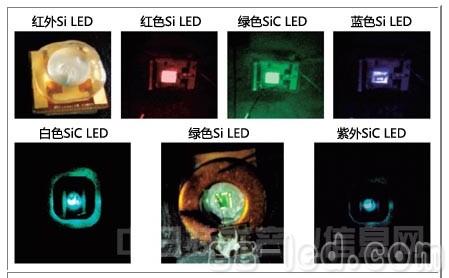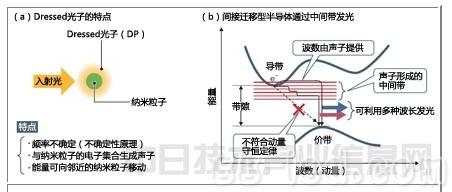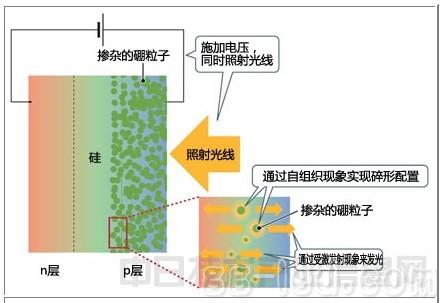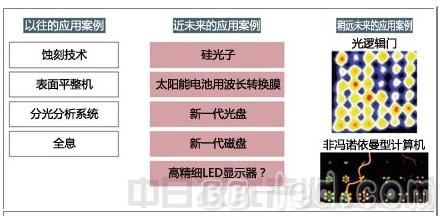The reason why the indirect migration semiconductor can emit light is that the "dressed photon" developed by the Otsu Research Laboratory has set up a "migratory bridge" for the energy band structure that could not be previously migrated.

Figure 1 Si and SiC LEDs can be freely illuminated by infrared, visible, and ultraviolet light. 
Figure 2 Dressed photons and phonons erected a luminous bridge
A Dressed photon is a photon that is attached to a nanoparticle like a "cloth" when the photons are combined with the electrons of the nanoparticle when the light is irradiated to the fine particles (nanoparticles). Otsu pointed out that photons combined with electrons on the surface of matter also have "surface plasmons", but "the difference between the two is that the frequency of the surface plasmons is constant, and the frequency of the Dressed photons is not fixed." Dajin explained that the reason is that the nanoparticles are very small, so the effect of the uncertainty principle is obvious. Moreover, until recently, Otsu had called it "near-field light," but "found during the research, it is more appropriate to call it a Dressed photon."
Electrons combined with Dressed photons form discrete energy levels (phonon levels). Otsu et al. realized the migration of electrons by forming energy levels in semiconductors.
The method of making a luminescent silicon LED "Dressed photon reference annealing method" is as follows (Fig. 3). When a p-layer of a silicon LED was produced, a current was applied to the silicon doped with boron (B), and annealed at 300 ° C for 10 minutes using Joule heat. At this point, the light is also illuminated from outside the component. Thus, the boron particles irradiated with the light form a phonon level and undergo a stimulated emission phenomenon, and emit light by using substantially the same wavelength as the irradiated light. After fabrication, the LED can emit light by injecting current without illuminating the light.

Figure 3: Self-organized impurities after irradiation
The focus here is on light. If the light is not illuminated, the stimulated emission will not occur and the LED will not emit light. Chuan Tianzhong, a special associate professor who led the research in the Otsu Research Laboratory, pointed out that the distribution of boron can also “spontaneously become shattered under the illumination of light (the same pattern or shape will appear when the details of a particular pattern or shape are enlarged). In addition, the wavelength of the light can be changed by selecting the illumination light. The wavelength longer than the band gap and the wavelength shorter than the band gap can be used. When the illumination light is turned white, an LED emitting white light can be produced.

Figure 4 “Dressed Photonics Engineering†expands into a variety of applications
These semiconductors are used in a wide range of applications. One of them is the "silicon photon" that can only use silicon to achieve light transmission. Previous examples of Dressed photonics applications, examples of applications in the near future, and future application examples. For example, this silicon LED can also directly become a high-efficiency solar cell that can generate electricity by using light having a longer or shorter wavelength than the band gap. The Otsu Research Office has started to verify this aspect and has confirmed that the conversion efficiency of solar cells can be increased by about two percentage points. Moreover, it is also expected to realize an inorganic material display that emits light like an organic EL.

Simplex SM / MM Fiber Pigtail SC / LC / ST/FC
Pigtails & patch cords can be supplied in a variety of lengths, colors and with a variety of different connector types. Different fiber types and cable diameters are also available on request.
Features of FC/UPC Multimode Fiber Optic Pigtails:
1) Superior qualified standard PC, APC, UPC, SPC polishing;
2) 100% optic test: Insertion Loss: ≤0.3 (PC); ≤0.2 (APC); ≤0.2 (UPC); ≤0.3 (SPC);
3) 100% optic test: Return Loss: ≥45 (PC); ≥60 (APC); ≥55 (UPC); ≥50 (SPC);
4) φ0.9mm, φ2.0mm, φ3.0mm cable optional;
5) Single mode (9125) or multi mode (50/125 or 62.5/125) fiber available;
6) FC, SC, LC, MU, ST, MT-RJ, etc connector
7) Simplex and duplex connector available; 8) Good exchange ability and good durability;
9) Available in fiber bunch, ribbon fan-out, pigtail available;
10) Meets ISO9001, ROHS and Bell core GR 326-core standards;
11) Customized specifications are welcomed.
Applications of FC/UPC Single mode Fiber Optic Pigtails:
1) CATV, metro test equipment;
2) Telecommunication networks;
3) Local area networks (LAN);
4) Wide area networks (WAN);
5) Premise installations;
6) Data processing networks;
7) Video and military active device termination.
Fiber Optic Pigtail,Robbon Optic Pigtail,Bundle Optic Pigtal,Fiber Pigtail
Chengdu Xinruixin Optical Communication Technology Co.,Ltd , https://www.xrxoptic.com